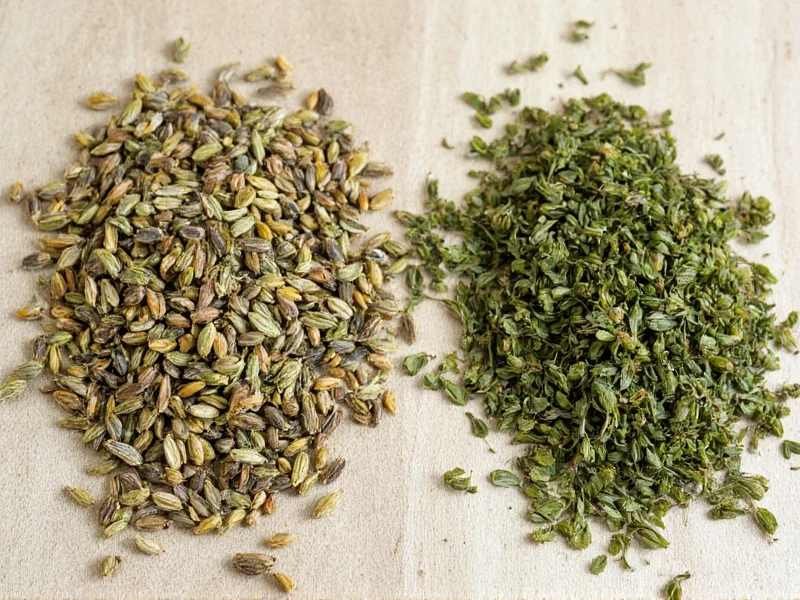Understanding herb conversions is essential for home cooks who frequently encounter recipes calling for fresh herbs when only dried versions are available. This knowledge prevents flavor imbalances that can ruin dishes through overpowering or underwhelming herb presence.
Why Herb Conversion Ratios Matter
Herbs lose approximately 70-85% of their weight during the drying process as water content evaporates. This concentration effect means dried herbs deliver more intense flavor per volume than fresh varieties. The 1:3 ratio serves as a reliable starting point, though certain factors may require adjustments:
- Herb type - Delicate herbs like basil and cilantro have different concentration levels than hardy varieties like rosemary and thyme
- Storage duration - Dried herbs lose potency over time, especially after 6-12 months
- Recipe type - Long-cooking dishes allow dried herbs more time to rehydrate and release flavor
Dried to Fresh Herb Conversion Chart
| Dried Herb (1 part) | Fresh Herb Equivalent | Best Substitution Notes |
|---|---|---|
| 1 teaspoon dried basil | 1 tablespoon fresh basil | Add dried basil early in cooking; fresh basil added at end |
| 1 teaspoon dried oregano | 1 tablespoon fresh oregano | Dried oregano works better in tomato-based dishes |
| 1/2 teaspoon dried rosemary | 1 1/2 teaspoons fresh rosemary | Use less dried rosemary - it's particularly potent |
| 1 teaspoon dried thyme | 1 tablespoon fresh thyme | Fresh thyme has more subtle flavor than dried |
| 1/4 teaspoon dried cilantro | 3/4 teaspoon fresh cilantro | Dried cilantro loses distinctive flavor; fresh preferred |
| 1 teaspoon dried dill | 1 tablespoon fresh dill | Dried dill works well in pickling; fresh better for garnish |
Practical Substitution Guidelines
When converting dried herbs to fresh in recipes, consider these practical tips for optimal results:
Timing Matters
Add dried herbs early in the cooking process to allow time for rehydration and flavor release. Fresh herbs typically benefit from being added during the last 5-10 minutes of cooking to preserve their delicate flavor compounds and vibrant color. For soups and stews, dried herbs should go in during the first half of cooking time.
Adjust for Potency
Not all dried herbs convert at exactly 1:3. Stronger herbs like rosemary, sage, and thyme often require a 1:2 ratio instead. More delicate herbs like tarragon and chives maintain closer to the standard ratio. When in doubt, start with less dried herb and adjust to taste.
Consider the Dish Type
Cold dishes like salads and dressings rarely substitute well with dried herbs, as they lack opportunity to rehydrate. For these applications, fresh herbs provide superior texture and flavor. Baked goods and long-simmering sauces offer the best opportunities for successful dried-to-fresh conversions.
When Substitutions Don't Work Well
Certain herbs don't translate well between dried and fresh forms. Cilantro loses its distinctive flavor when dried, making fresh the only acceptable option for authentic Mexican or Asian dishes. Similarly, fresh dill's unique flavor profile diminishes significantly when dried, though dried dill works acceptably in pickling recipes.
Recipes specifically highlighting herb freshness—like pesto, chimichurri, or tabbouleh—should never use dried herbs as substitutes. These dishes rely on the vibrant texture and bright flavor that only fresh herbs provide.
Maximizing Herb Potency
Proper storage significantly impacts herb effectiveness. Keep dried herbs in airtight containers away from light and heat, replacing them every 6-12 months. Fresh herbs maintain best quality when stored with stems in water (like flowers) and covered loosely with a plastic bag in the refrigerator.
When substituting, always crush dried herbs between your fingers before adding them to release essential oils. For fresh herbs, chop them just before use to prevent oxidation that diminishes flavor.
Developing Your Palate for Herb Substitutions
The most reliable approach to herb conversions involves tasting as you cook. Start with the standard conversion ratio, then adjust based on your specific ingredients and preferences. Remember that soil conditions, growing season, and harvest time affect herb potency, making exact conversions somewhat variable.
Experienced cooks develop intuition about herb substitutions through practice. Keep notes about successful conversions in your recipe journal to refine your personal conversion ratios over time. This personalized approach often yields better results than rigid adherence to standard ratios.
What's the most accurate conversion ratio for dried to fresh herbs?
The standard conversion ratio is 1:3 (1 part dried to 3 parts fresh), but this varies by herb type. Stronger herbs like rosemary and thyme often use a 1:2 ratio, while delicate herbs follow the 1:3 standard. Always start with less dried herb and adjust to taste during cooking.
Can I substitute dried herbs for fresh in all recipes?
No, certain recipes don't work well with substitutions. Cold dishes like salads, dressings, and fresh sauces (pesto, chimichurri) require fresh herbs for proper texture and flavor. Dried herbs work best in cooked dishes with sufficient moisture and cooking time to rehydrate them.
How do I adjust herb quantities when a recipe doesn't specify dried or fresh?
When recipes simply say "herbs" without specification, assume fresh herbs are intended. If using dried instead, reduce the quantity to one-third of the stated amount. For example, if a recipe calls for 1 tablespoon of "thyme," use 1 teaspoon dried thyme instead of 1 tablespoon fresh.
Do dried herbs lose potency over time?
Yes, dried herbs gradually lose potency. Most maintain peak flavor for 6-12 months when stored properly in airtight containers away from light and heat. After this period, you may need to increase quantities slightly when substituting for fresh herbs, though extremely old dried herbs often develop stale, musty flavors that cannot be compensated for.
Which herbs convert best from dried to fresh?
Hardy herbs with woody stems convert most successfully: oregano, thyme, rosemary, and marjoram. Delicate herbs like cilantro, dill, and tarragon lose significant flavor when dried and don't substitute as well. Mediterranean herbs generally dry better than their more delicate counterparts.











 浙公网安备
33010002000092号
浙公网安备
33010002000092号 浙B2-20120091-4
浙B2-20120091-4